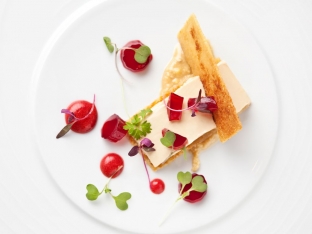Molecular cuisine – these are innovative solutions applied in cooking, including all scientific developments in the preparation of familiar dishes. Molecular cuisine is characterized by a scientific approach and extreme precision. Molecular cuisine has become famous for its ideal dishes, containing almost no fat, but excellent in taste.
Since the beginning of the century, molecular cuisine has taken a firm place at the forefront of the culinary world. The title of the best restaurant was given to the restaurant of molecular cuisine – this was the beginning of the annual victorious procession of molecular chefs. Names in this industry have become known throughout the world: Nicholas Curti, Elizabeth Thomas, Heston Blumenthal and Ferrand Adria, Thomas Keller. They became the founders of molecular cuisine and co-authors of a kind of manifesto, declaring to the world about the birth of a new cuisine: “We use all the technical innovations, but our cuisine is characterized by the desire to create ever more perfect dishes.” And although many names were considered for the new direction of culinary art, it was the defining concept of "molecular cuisine" that took root. So unusual dishes got the appropriate name.
Components of molecular cuisine – all curiositiesMolecular cuisine cooking methods are varied and reminiscent of science fiction: air foams, vacuum water baths, syringes and pipettes, centrifuges and unpronounceable components of many products – these are the few names that are found in molecular cuisine at every turn. Let us consider a part of this variety of forms and contents.
Transglutaminase – an enzyme that connects muscle tissues into a single mass, capable of taking on a completely unimaginable form, if the molecular chef so desires. This is the principle of creating "crab sticks", noodles and even living tissue, if it comes to medicine (the principle of blood clotting). A striking example of the — soy sauce & miso soup – traditional Japanese food.
Dry Ice — it is frozen carbon dioxide. Its effectiveness is well known to fans & nbsp; rock concerts. It is not recommended to inhale it for a long time, but as an accompaniment to ice cream or champagne, it looks mysterious and is remembered for a long time. Dry ice is also used in sodas and in horror films to create a mysterious foggy atmosphere and attract attention. That is why it has become a great addition to molecular cuisine. The dish "smokes" and the main aroma envelops the visitor in delicious vapors, increasing appetite.
Rotary evaporator – at reduced pressure, removes concentrated flavor from the product by evaporating liquids. The temperature may be below 20oC. The use of a rotary evaporator is required for particularly complex, but easily disappearing aromas of dishes, liquids with essential oils. If you put water and lavender in a rotary evaporator, get lavender concentrate. With traditional evaporation, it will not be so expressive and saturated. Extracted essences are used to fill spheres and gels, & nbsp; complementing dishes with shape and texture with special flavors. Ice cream flavored with tea roses or meat in a rosemary haze – these masterpieces of molecular cuisine will amaze anyone.

So, we looked at drinks, desserts, their amazing design. Now let's look at a couple of molecular cuisine recipes that can be prepared on the eve of All Saints' Day, also known as Halloween.
Ominous smoke over a glass of La Llorona cocktail
Ingredients:
- 90 ml. brandy;
- 30 ml. lemon juice;
- 30 ml. lime juice;
- 1.5 tbsp. l. sugar;
- dash of Angostura;
- crushed ice and dry ice.
- In a shaker, mix all the ingredients of the cocktail without Angostura, shake for 10-15 seconds, strain, pour into martini glasses.
- Drop Angostura into each glass with a cocktail and put dry ice.
Green Ghost Cocktail
- 1 part green melon liqueur (Midori Melon);
- 1/2 part Yellow Chartreuse;
- 1/2 part Canton Ginger;
- ginger beer.
- Mix liqueurs in a shaker with crushed ice.
- Fill glass 2/3 full and top with ginger beer.
- Add dry ice and lime slice.






Add a comment